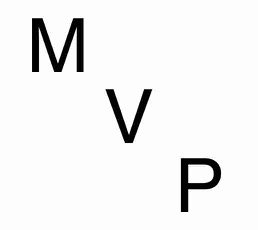MVP is a marketing exercise not a technology exercise
… Minimally Viable Product
Possibly the most fashionable and misused term the digital industry right now. The term seems to be used by one-side-or-other to criticise the other.
I recently heard another Agile Coach say: “If you just add a few more features you’ll have an MVP” – I wanted to scream “Wrong, wrong, wrong!” But I bit my tongue (who says I’m can’t do diplomacy?)

MVP often seems to be the modern way of saying “The system must do”, MVP has become the M in Moscow rules.
Part of the problem is that the term means different things to different people. Originally coined to describe an experiment (“what is the smallest thing we could build to learn something about the market?”) it is almost always used to describe a small product that could satisfy the customers needs. But when push comes to shove that small usually isn’t very small. When MVP is used to mean “cut everything to the bone” the person saying it still seems to leave a lot of fat on the bone.
I think non-technical people hear the term MVP and think “A product which doesn’t do all that gold plating software engineering fat that slows the team down.” Such people show how little they actually understand about the digital world.
MVPs should not about technology. An MVP is not about building things.
An MVP is a marketing exercise: can we build something customers want?
Can we build something people will pay money for?
Before you use the language MVP you should assume:
- The technology can do it
- Your team can build it
The question is: is this thing worth building? – and before we waste money building something nobody will use, let alone pay for, what can we build to make sure we are right?
The next time people start sketching an MVP divide it in 10. Assume the value is 10% of the stated value. Assume you have 10% of the resources and 10% of the time to build it. Now rethink what you are asking for. What can you build with a tenth?
Anyway, the cat is out of the bag, as much as I wish I could erase the abbreviation and name from collective memory I can’t. But maybe I can change the debate by differentiating between several types of MVP, that is, several different ways the term MVP is used:
- MVP-M: a marketing product, designed to test what customers want, and what they will pay for.
- MVP-T: a technical product designed to see if something can be build technologically – historically the terms proof-of-concept and prototypehave been used here
- MVP-L: a list of MUST HAVE features that a product MUST HAVE
- MVP-H: a hippo MVP, a special MVP-L, that is highest paid person’s opinion of the feature list, unfortunately you might find several different people believe they have the right to set the feature list
- MVP-X: where X is a number (1,2, 3…), this derivative is used by teams who are releasing enhancements to their product and growing it. (In the pre-digital age we called this a version number.) Exactly what is minimal about it I’m not sure but if it helps then why not?
MVP-M is the original meaning while MVP-L and MVP-H are the most common types.
So next time someone says “MVP” just check, what do they mean?
| Published on Java Code Geeks with permission by Allan Kelly, partner at our JCG program. See the original article here: MVP is a marketing exercise not a technology exercise Opinions expressed by Java Code Geeks contributors are their own. |


